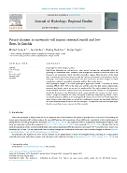Future changes in snowpack will impact seasonal runoff and low flows in Czechia

Datum vydání
2021Publikováno v
Journal of Hydrology: Regional Studies [online]Ročník / Číslo vydání
37 (October)ISBN / ISSN
ISSN: 2214-5818ISBN / ISSN
eISSN: 2214-5818Metadata
Zobrazit celý záznamKolekce
Tato publikace má vydavatelskou verzi s DOI 10.1016/j.ejrh.2021.100899
Abstrakt
Study Region Central Europe, Czechia. Study Focus Mountains are referred to as "water towers" because they substantially affect the hydrology of downstream areas. However, snow storages will decrease in the future due to the increase in air temperature which will affect streamflow regime. Main objectives of this study were 1) to simulate the future changes in snow for a large set of mountain catchments in Czechia, reflecting a wide range of climate projections and 2) to analyse how the snow changes will affect groundwater recharge, streamflow seasonality and low flows in the future. New Hydrological Insights The future hydrological projections showed a decrease in annual maximum SWE by 30 %-70 % in the study area until the end of the 21st century. Additionally, snowmelt was found to occur on average 3-4 weeks earlier. The results showed the large variability between individual climate chains and indicated that the increase in air temperature causing the decrease in snowfall might be partly compensated by the increase in winter precipitation. Changes in snowpack will cause the highest streamflow during melting season to occur one month earlier, in addition to lower spring runoff volumes due to lower snowmelt inputs. The future climate projections leading to overall dry conditions in summer are associated with both the lowest summer precipitation and seasonal snowpack. The expected lower snow storages might therefore contribute to more extreme low flow periods.
Klíčová slova
climate change, snow, snowmelt runoff, seasonal runoff, low flows
Trvalý odkaz
https://hdl.handle.net/20.500.14178/1753Licence
Licence pro užití plného textu výsledku: Creative Commons Uveďte původ-Neužívejte dílo komerčně-Nezpracovávejte 4.0 International






